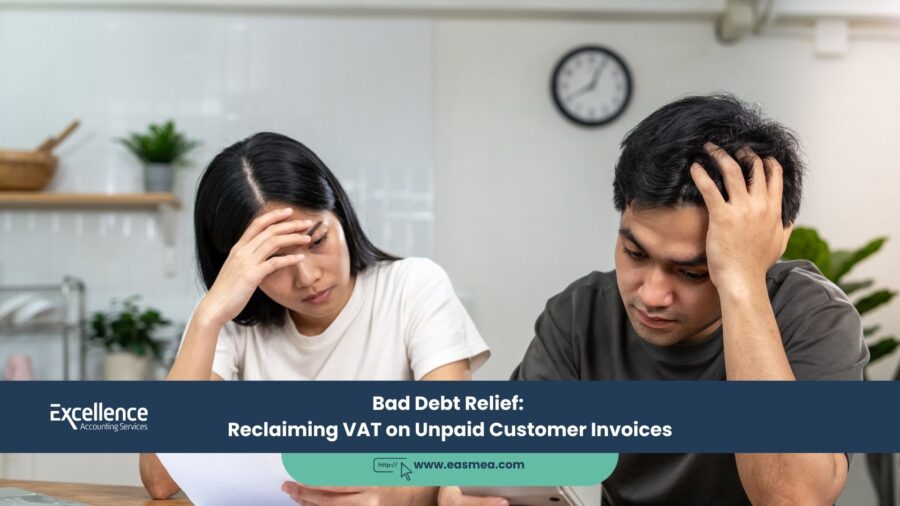Bad Debt Relief: Reclaiming VAT on Unpaid Customer Invoices in the UAE
One of the most frustrating challenges for any business is a customer who doesn’t pay their invoice. Not only do you lose the revenue you earned, but under the UAE VAT system, you are still legally obligated to pay the 5% VAT to the Federal Tax Authority (FTA) based on the invoice you issued. This means you are out of pocket for both the service you delivered and the tax on it—a painful double loss.
- Bad Debt Relief: Reclaiming VAT on Unpaid Customer Invoices in the UAE
- The Six Conditions for Claiming Bad Debt Relief
- How to Claim the Relief on Your VAT Return
- Navigating Bad Debt and VAT with Excellence Accounting Services (EAS)
- Frequently Asked Questions (FAQs)
- Don't Let Unpaid Invoices Cost You Twice.
Fortunately, the UAE VAT Law provides a critical safety net for this exact situation: **Bad Debt Relief**. This is a specific provision that allows a business to reclaim the output VAT it has already paid to the FTA on an invoice that has subsequently become a “bad debt.” However, this relief is not automatic. To claim it, a business must meet a strict set of conditions laid out by the FTA. Failure to meet any one of these conditions can result in the claim being rejected.
This guide will provide a clear and comprehensive explanation of how to claim Bad Debt Relief in the UAE. We will detail the six essential conditions, explain the process for making the adjustment on your VAT return, and provide a practical example to illustrate how it works.
Key Takeaways
- Purpose: Bad Debt Relief allows you to recover the output VAT you paid to the FTA on sales invoices that your customers have failed to pay.
- Six Conditions Must Be Met: You cannot claim the relief unless all six conditions set by the FTA are satisfied. The most important are that the debt is over 6 months old and you have written it off in your books.
- It’s an Adjustment, Not a Refund: You claim the relief by making a negative adjustment to the Output Tax (Box 1) of your VAT return.
- Customer Must Also Adjust: If you claim bad debt relief, your customer (if they are VAT-registered) is legally required to reverse the corresponding input tax they may have already claimed.
- Documentation is Crucial: You must maintain all records proving that you have met the conditions, such as evidence of chasing the debt and the accounting entry for the write-off. Expert VAT consultancy is vital for this.
The Six Conditions for Claiming Bad Debt Relief
Before you can make any adjustment on your VAT return, you must be able to prove that you have met all of the following six conditions for the specific invoice in question:
- Goods and Services have been Supplied: You must have actually delivered the goods or performed the service as stated on the invoice.
- VAT was Declared and Paid: You must have already declared the output VAT on a previous VAT return and paid it to the FTA.
- More Than Six Months Have Passed: At least six months must have passed since the date of the supply.
- The Customer Has Not Paid: The consideration (the payment) for the supply has not been received, in whole or in part.
- The Debt is Written Off: You have written off the receivable as a bad debt in your accounting books. This is a formal accounting entry.
- You Have Notified the Customer: You must have notified your customer in writing that you are writing off the debt.
Meeting all six conditions is non-negotiable. If you are missing even one—for example, you haven’t formally written off the debt in your accounts—your claim for relief will be invalid.
How to Claim the Relief on Your VAT Return
Claiming the relief is done by making a downward adjustment to your output tax. You do not claim it as input tax.
The process is as follows:
- Calculate the amount of VAT you originally paid on the bad debt.
- In your VAT return for the period in which you met all six conditions, you make a negative adjustment to **Box 1: Standard Rated Supplies**.
- This adjustment will reduce your total output tax due for the period, effectively refunding you the VAT you previously paid.
A Practical Example:
Let’s say “Creative Consultants LLC” issued an invoice to a client on **January 10, 2024**.
- Invoice Amount: AED 10,000
- VAT (5%): AED 500
- Total Due: AED 10,500
Creative Consultants declared and paid the AED 500 output VAT to the FTA in their Q1 2024 VAT return. Despite numerous reminders, the client never pays. By **August 2024**, the invoice is over six months old. The company decides to write it off.
Actions taken in August 2024:
- The accountant makes a journal entry to write off the AED 10,500 receivable from the books.
- The company sends an email to the client informing them that the debt of AED 10,500 has been written off.
Now, all six conditions have been met. In their Q3 2024 VAT return, Creative Consultants can claim Bad Debt Relief.
VAT Return Adjustment (Q3 2024):
- They will make an adjustment of **negative AED 10,000** to the value of their standard-rated supplies in Box 1.
- This will result in a corresponding **negative AED 500** adjustment to the output VAT calculated for that box.
This AED 500 will reduce the total VAT they have to pay to the FTA for the third quarter, effectively giving them their money back.
Navigating Bad Debt and VAT with Excellence Accounting Services (EAS)
Managing accounts receivable is challenging enough without the added complexity of tax compliance. EAS provides expert support to ensure you manage bad debts correctly and recover every dirham of VAT you are entitled to.
- Expert VAT Consultancy: We provide clear guidance on the Bad Debt Relief conditions and help you determine your eligibility to make a claim.
- Accounts Receivable Management: We can assist in managing your receivables process to minimize the risk of bad debts in the first place.
- VAT Return Filing: We manage your VAT return filing, ensuring that any Bad Debt Relief claims are correctly calculated and reported.
- Accounting and Bookkeeping Support: We ensure that the necessary “write-off” entries are correctly recorded in your books, a critical condition for claiming the relief.
Frequently Asked Questions (FAQs)
If you recover the payment (in whole or in part) after claiming the relief, you must reverse the process. You are required to declare and repay the corresponding amount of VAT to the FTA in the VAT return for the period in which you received the payment.
You can only claim Bad Debt Relief on the portion of the invoice that remains unpaid. For example, if a customer paid AED 2,100 of the AED 10,500 invoice, you can only claim relief on the VAT related to the unpaid AED 8,400 (which is VAT of AED 400).
While the debt must be at least six months old, there is no upper time limit specified in the law for making the claim, as long as you meet all the conditions in the period you make the claim.
The notification must be in writing. An email is generally sufficient. It should clearly state the invoice number and the amount that is being written off as a bad debt.
If your customer is VAT-registered and has already claimed the input tax on your invoice, they are legally obligated to make a corresponding downward adjustment to their input tax claim once they receive your notification. This prevents both parties from getting a tax benefit.
No. If you are on the Cash Accounting Scheme, you only account for output VAT when you actually receive payment from your customers. Since you would not have paid any VAT to the FTA on an unpaid invoice, there is no VAT to reclaim, and Bad Debt Relief is not applicable.
The concept is similar but the rules are different. For Corporate Tax, you can generally claim a deduction for bad debts written off. However, the conditions for a corporate tax deduction may differ from the six specific conditions required for VAT Bad Debt Relief.
Taking legal action is strong evidence that you have made efforts to collect the debt and supports your decision to write it off. While not a mandatory condition, it strengthens your position if the FTA were to review your claim.
No. The “more than six months” rule is a strict condition. Even if you know with certainty that the debt will never be paid, you must wait for the six-month period to pass before you can claim the relief.
You should keep a copy of the original tax invoice, proof that you declared and paid the VAT, evidence of your attempts to collect the payment, a copy of the notification sent to the customer, and the accounting records showing the debt being written off.
Conclusion: A Fair and Necessary Provision
Bad Debt Relief is a fair and essential mechanism within the UAE VAT system that protects businesses from being unfairly penalized for their customers’ non-payment. However, it is a relief that must be earned through diligent process and meticulous record-keeping. By understanding and strictly adhering to the six conditions, businesses can confidently reclaim the VAT they are owed and better manage the financial impact of bad debts.
Don't Let Unpaid Invoices Cost You Twice.
Contact Excellence Accounting Services for expert guidance on VAT compliance and accounts receivable management.




